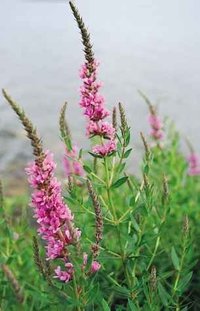Purple loosestrife
|
|
| Purple Loosestrife | ||||||||||||||
|---|---|---|---|---|---|---|---|---|---|---|---|---|---|---|
 | ||||||||||||||
| Scientific classification | ||||||||||||||
| ||||||||||||||
| Binomial name | ||||||||||||||
| Lythrum salicaria |
Purple loosestrife (Lythrum salicaria)—also known as Spiked loosestrife, Purple lythrum, Rainbow weed or Salicaire—is a semi-aquatic herbaceous plant belonging to the loosestrife family, Lythraceae. A perennial native to the wetlands of Eurasia, Purple loosestrife has become an invasive species since its introduction into temperate New Zealand and North America where it is now considered a noxious weed. It should not be confused with other plants sharing the name loosestrife that are members of the Primrose family, Primulaceae.
Once enjoyed as a medicinal herb and as an attractive garden plant, purple loosestrife has had a destructive impact on North American wetland ecology since the early 19th century. The plants grow vigorously and spread alarmingly fast, far removed from their natural controlling agents. Infestations result in dramatic disruption in water flow in rivers and canals, and a sharp decline in biological diversity. Native food and cover plant species, notably the cattails, are completely crowded out.
Purple loosestrife may rise two metres in height and 1.5 metres in width with up to 50 erect stalks to a single woody root mass. The wide, downy and sessile leaves are 3-10 centimetres in length and opposite in two ranks. Although easily identified during its blooming season from June to September, purple loosestrife may be distinguished from similar native plants (i.e. fireweed, Epilobium angustifolium; blue vervain, Verbena hastata; blazing stars, Liatris spp. and spirea, Spiraea douglasii) by its angular stalks which are square in outline.
The distinctive, showy spires of reddish purple flowers are clustered tightly in the axils of bracts or leaves; the flowers have 5-6 petals. After their long blooming period the plant's leaves turn bright red through dehydration. Occurring in early autumn, the red colour may last for almost two weeks. The dead stalks from previous growing seasons are also a distinctive shade of brown.
Erie_Lock4083.jpg
A single plant may produce up to three million tiny seeds annually. Easily carried by wind and water, the seeds germinate in moist soils after overwintering. Once established, infestations are extremely difficult and costly to remove by mechanical and chemical means. An alternative has been sought in biological pest control; the release of insects into North America known to feed exclusively on purple loosestrife has met with considerable success. Use of the four insect species - two beetles (Galerucella calmariensis and G. pusilla) and two weevils (Hylobius transversovittatus and Nanophyes marmoratus) provides an effective alternative to harmful herbicides in sensitive ecosystems.
In Europe the plant is fed upon by the larvae of some Lepidoptera species including The Engrailed.
See also
External links
- Purple loosestrife InfoCentre (http://www.ducks.ca/purple/index.html)de:Blutweiderich
